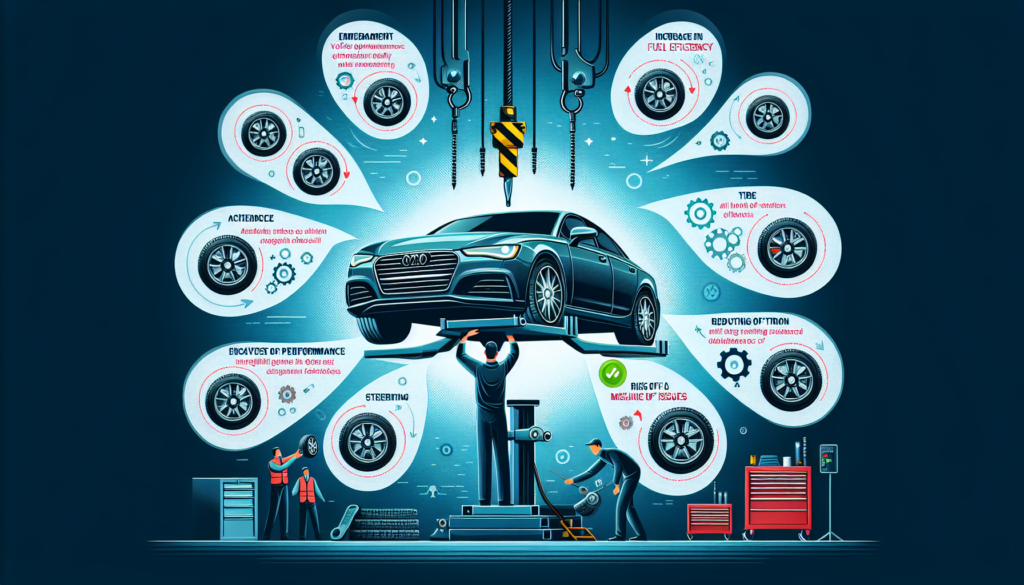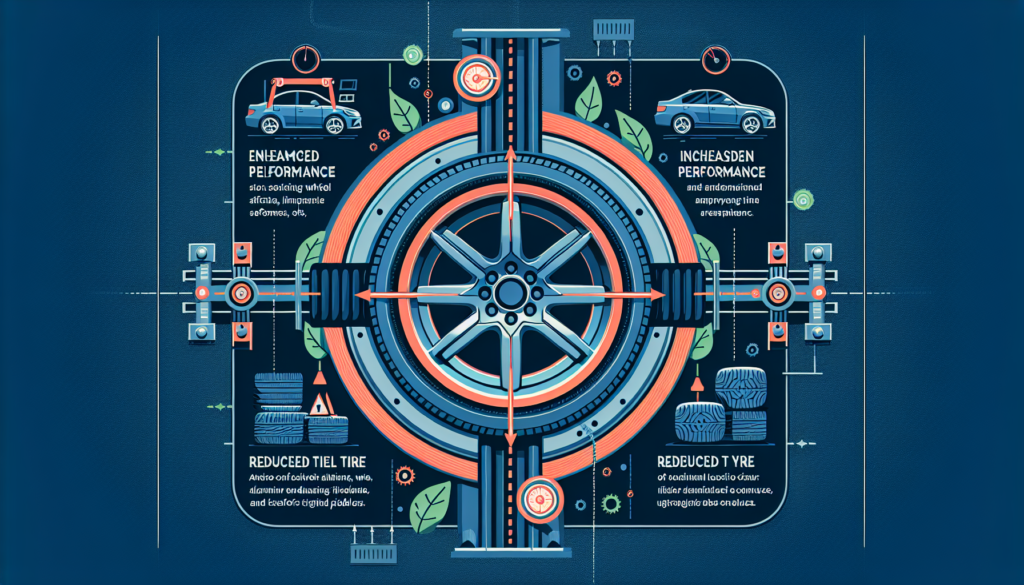Have you ever wondered if something as simple as wheel alignment can actually make a difference in road safety? Well, the answer may surprise you. In this article, we will explore the impact of wheel alignment on road safety and how this often overlooked maintenance task can play a crucial role in preventing accidents and ensuring a smooth and safe driving experience for all. So, buckle up and get ready to learn how a small adjustment can have a big impact on the safety of our roads.

Importance of Wheel Alignment
Proper wheel alignment is a crucial aspect of vehicle maintenance that is often overlooked by many drivers. Ensuring that your wheels are correctly aligned not only enhances your driving experience but also plays a vital role in ensuring road safety. By aligning your wheels, you can minimize various issues that can compromise your vehicle’s stability, handling, tire performance, fuel efficiency, suspension, driver comfort, and overall safety. In this article, we will explore the effects of misaligned wheels and the benefits of proper wheel alignment in detail.
Road Safety Issues Caused by Misaligned Wheels
Decreased Vehicle Stability
Misaligned wheels can significantly impact your vehicle’s stability, putting you and others on the road at risk. When your wheels are not aligned properly, it can cause your vehicle to pull to one side, making it more challenging to keep it in a straight line. This pulling effect can make it difficult to maintain control of your vehicle, especially in hazardous driving conditions or during sudden maneuvers. By having your wheels correctly aligned, you can ensure maximum stability, reducing the chances of losing control and potentially causing an accident.
Uneven Tire Wear
Another significant issue caused by misaligned wheels is uneven tire wear. When your wheels are not properly aligned, they may cause your tires to wear unevenly, with certain areas of the tire experiencing more friction and wear than others. This uneven wear not only compromises the integrity of your tires but also reduces their lifespan. Bald or unevenly worn tires can lead to decreased traction, especially on wet or slippery roads, increasing the risk of accidents. By aligning your wheels regularly, you can ensure even tread wear and prolong the life of your tires, thereby enhancing road safety.
Reduced Braking Efficiency
Misaligned wheels can also impact your vehicle’s braking efficiency. When your wheels are not aligned properly, they can result in uneven weight distribution across your tires. This imbalance affects the uniformity of braking force applied to each tire, leading to reduced braking efficiency. In emergency situations, where every second matters, having wheels properly aligned can make a significant difference in your vehicle’s ability to come to a quick and controlled stop. Ensuring optimal alignment enhances your braking system’s effectiveness, allowing you to respond more effectively to sudden obstacles or hazards on the road, and ultimately improving road safety.
Wheel Alignment and Vehicle Handling
Effect on Steering Response
Proper wheel alignment is essential for optimal steering response. When your wheels are aligned correctly, it allows for precise and predictable steering control. On the other hand, misaligned wheels can result in sluggish or unresponsive steering, making it more challenging to navigate turns or maneuver in tight spaces. This lack of responsiveness can cause a delay in your ability to react to potential hazards, potentially leading to accidents. By maintaining proper wheel alignment, you can ensure crisp and immediate steering response, enabling you to maneuver your vehicle safely and effectively in various driving scenarios.
Impact on Cornering Ability
In addition to steering response, wheel alignment also influences your vehicle’s cornering ability. Proper alignment ensures that all four wheels are working together to provide optimal stability and grip during turns. Misaligned wheels, however, can disrupt this balance, resulting in uneven weight distribution and reduced cornering ability. When your wheels are aligned correctly, they can maintain better contact with the road surface, enhancing traction and allowing you to take turns with more confidence and control. This improved cornering ability not only enhances your driving experience but also significantly contributes to road safety, as you can navigate curves and corners more effectively without the risk of skidding or losing control.
Alignment’s Role in Tire Performance
Preserving Tire Life
Proper wheel alignment plays a crucial role in preserving the life of your tires. When your wheels are not aligned correctly, it can cause uneven tire wear, leading to premature tire degradation and the need for frequent replacements. By aligning your wheels, you can ensure that the weight is evenly distributed across your tires, resulting in even tread wear. This even wear pattern prolongs the lifespan of your tires, saving you money on replacements and reducing the risk of tire failure on the road. Regular wheel alignment, therefore, not only improves road safety but also helps you maintain your tires in optimal condition, ensuring maximum performance and grip.
Enhanced Traction and Grip
Wheel alignment also has a direct impact on your tires’ traction and grip. When your wheels are correctly aligned, all four tires can maintain optimal contact with the road surface, providing superior grip and traction. This enhanced traction is particularly crucial in challenging driving conditions, such as wet or icy roads, where maintaining control can be increasingly difficult. Proper alignment allows your tires to effectively channel water or snow away from the tread, reducing the risk of hydroplaning or losing traction. By improving your tires’ grip, alignment significantly enhances your vehicle’s stability and maneuverability, promoting road safety in various weather and road conditions.

Impact of Wheel Alignment on Fuel Efficiency
Reduced Rolling Resistance
Proper wheel alignment contributes to improved fuel efficiency by reducing rolling resistance. Rolling resistance refers to the energy required to overcome the friction between the tires and the road surface. Misaligned wheels can increase rolling resistance, forcing your engine to work harder and consume more fuel to maintain the same speed. By aligning your wheels correctly, you can minimize rolling resistance, allowing your vehicle to move more smoothly and more efficiently. This reduction in rolling resistance translates to better fuel economy, ultimately saving you money on fuel costs and reducing your vehicle’s carbon footprint.
Optimal Fuel Consumption
In addition to reducing rolling resistance, proper wheel alignment ensures optimal fuel consumption. When your wheels are aligned correctly, your tires roll in a straight line with minimal drag, allowing the vehicle to glide effortlessly. Misaligned wheels, on the other hand, can cause the tires to drag or scrub against the road surface, further increasing fuel consumption. By aligning your wheels, you can achieve the most efficient movement, reducing the strain on your engine and optimizing fuel consumption. Better alignment translates to fuel savings, promoting eco-friendly driving habits and contributing to a greener environment.
Alignment’s Influence on Vehicle Suspension
Smooth Ride Quality
Proper wheel alignment has a significant impact on your vehicle’s suspension system and, consequently, your overall ride quality. When your wheels are aligned correctly, it distributes weight evenly across your suspension components, allowing them to work harmoniously and absorb road imperfections. Misaligned wheels, however, can place excessive strain on certain suspension parts, leading to premature wear and compromised ride quality. By maintaining proper wheel alignment, you can ensure a smooth and comfortable ride, minimizing vibrations and bumps, and reducing the risk of suspension failure. A well-aligned suspension system contributes to a more enjoyable driving experience and enhances road safety.
Minimizing Strain on Suspension Components
Misaligned wheels can have a detrimental impact on your vehicle’s suspension components. When your wheels are not aligned properly, it can cause increased stress and strain on various suspension parts, such as the shocks, struts, and control arms. This excess strain can lead to accelerated wear and tear, resulting in costly repairs or, even worse, sudden suspension failure while driving. By aligning your wheels regularly, you can prevent unnecessary strain on your suspension components, ensuring their longevity and reliability. Proper alignment protects your vehicle’s suspension system, minimizing the risk of unexpected breakdowns and promoting safer journeys.

Alignment’s Contribution to Driver Comfort and Safety
Improved Handling and Control
Proper wheel alignment directly contributes to improved handling and control of your vehicle. When your wheels are aligned correctly, your vehicle responds more precisely to your steering inputs, allowing you to navigate through traffic and maneuver smoothly. Misaligned wheels, however, can make your vehicle feel unstable and difficult to control, compromising your ability to react to sudden situations on the road. By maintaining proper alignment, you can enjoy enhanced handling and control, promoting a safer and more enjoyable driving experience for yourself and those around you.
Reduced Driver Fatigue
Driving with misaligned wheels can be a tiring and fatiguing experience. The constant effort required to keep your vehicle in a straight line due to pulling or drifting can strain your muscles and wear you out quickly. This driver fatigue not only affects your comfort but also impairs your concentration and reaction time, increasing the risk of accidents. However, by aligning your wheels correctly, you can eliminate the need for constant steering correction, reducing driver fatigue and promoting alertness on the road. Improved driver comfort and reduced fatigue contribute to safer driving conditions, allowing you to stay focused and respond effectively to potential hazards.
Alignment as a Preventive Maintenance Measure
Detecting Alignment Issues before Major Problems Arise
Regular wheel alignment serves as a preventive maintenance measure, allowing you to detect alignment issues before they escalate into major problems. During the alignment process, a trained technician examines the angles and geometry of your wheels, identifying any deviations from the manufacturer’s specifications. Any misalignment can be corrected promptly, preventing further damage to your tires, suspension, and other critical components. By addressing alignment issues early on, you can avoid expensive repairs in the future and prevent potential breakdowns or accidents caused by neglected wheel alignment.
Preventing Expensive Repairs
Neglecting wheel alignment can lead to more significant and costly repairs down the line. Misaligned wheels can adversely affect various components of your vehicle, from tires and suspension to steering and braking systems. Uneven tire wear, premature tire failure, suspension damage, and misaligned steering can all result from prolonged misalignment. By regularly aligning your wheels, you can prevent these issues from occurring, ensuring that your vehicle operates optimally, reducing the risk of unexpected breakdowns, and saving you from expensive repair bills. Wheel alignment is an investment in the longevity and reliability of your vehicle, promoting road safety while also protecting your wallet.

Professional Wheel Alignment vs. DIY
Benefits of Professional Alignment
While the temptation to save money by attempting a DIY wheel alignment may be strong, it is essential to understand the benefits of professional alignment. Professional alignment performed by skilled technicians using specialized equipment ensures the highest level of precision and accuracy. They have the expertise to assess and adjust the wheel angles, toe, camber, and caster, to align them precisely according to the manufacturer’s specifications. Furthermore, professional alignment services often include a comprehensive inspection of your suspension and steering components, allowing for early detection of potential issues. By opting for professional alignment, you can be confident that your wheels are properly aligned, promoting road safety and giving you peace of mind.
Risks of Incorrect DIY Alignment
Attempting a DIY wheel alignment without proper knowledge, tools, and equipment can result in more harm than good. Accurate alignment requires precise measurements and adjustments, which are challenging to achieve without the necessary expertise and specialized tools. Incorrect alignment can worsen the existing misalignment, leading to further damage to your tires, suspension, and other vital components. Without professional guidance, you may miss subtle signs of misalignment or fail to address underlying issues. It is always best to leave wheel alignment to the professionals to ensure safety, reliability, and optimal performance of your vehicle.
Wheel Alignment and Road Safety: Statistics and Research
Studies on the Connection between Alignment and Accidents
Several studies have established a direct connection between wheel alignment and road accidents. Research conducted by various organizations, including automotive safety institutes, has consistently shown that misaligned wheels significantly increase the risk of accidents. It has been observed that vehicles with misaligned wheels are more prone to loss of control, reduced maneuverability, and increased stopping distances. These factors contribute to a higher likelihood of collisions and accidents on the road. Proper wheel alignment, therefore, emerges as a crucial factor in ensuring road safety by minimizing such risks.
Statistics on Accidents Caused by Misaligned Wheels
Accidents caused by misaligned wheels are unfortunately more common than one might think. According to statistics compiled by road safety organizations, a significant percentage of accidents can be attributed to poor wheel alignment. Studies have shown that misaligned wheels contribute to oversteering and understeering conditions, where a driver loses control of the vehicle during turns or fails to negotiate curves properly. Inadequate alignment also leads to tire blowouts, tire separation, and reduced braking efficiency. These factors collectively contribute to a substantial number of accidents every year. By maintaining proper wheel alignment, drivers can actively work towards reducing accident rates and ensuring a safer driving environment for everyone.
In conclusion, wheel alignment plays a crucial role in improving road safety. Misaligned wheels can have adverse effects on vehicle stability, tire performance, fuel efficiency, suspension, driver comfort, and overall handling. By regularly aligning your wheels, you can mitigate these issues and enjoy a safer, smoother, and more efficient driving experience. With the help of professional wheel alignment services, you can ensure optimal alignment tailored to your vehicle’s specifications, preventing potential accidents, expensive repairs, and unnecessary wear on critical components. Remember, prioritizing wheel alignment is not just about your safety, but also about the safety of everyone sharing the road with you. So, take the necessary steps to align your wheels properly and drive confidently towards a safer future.


